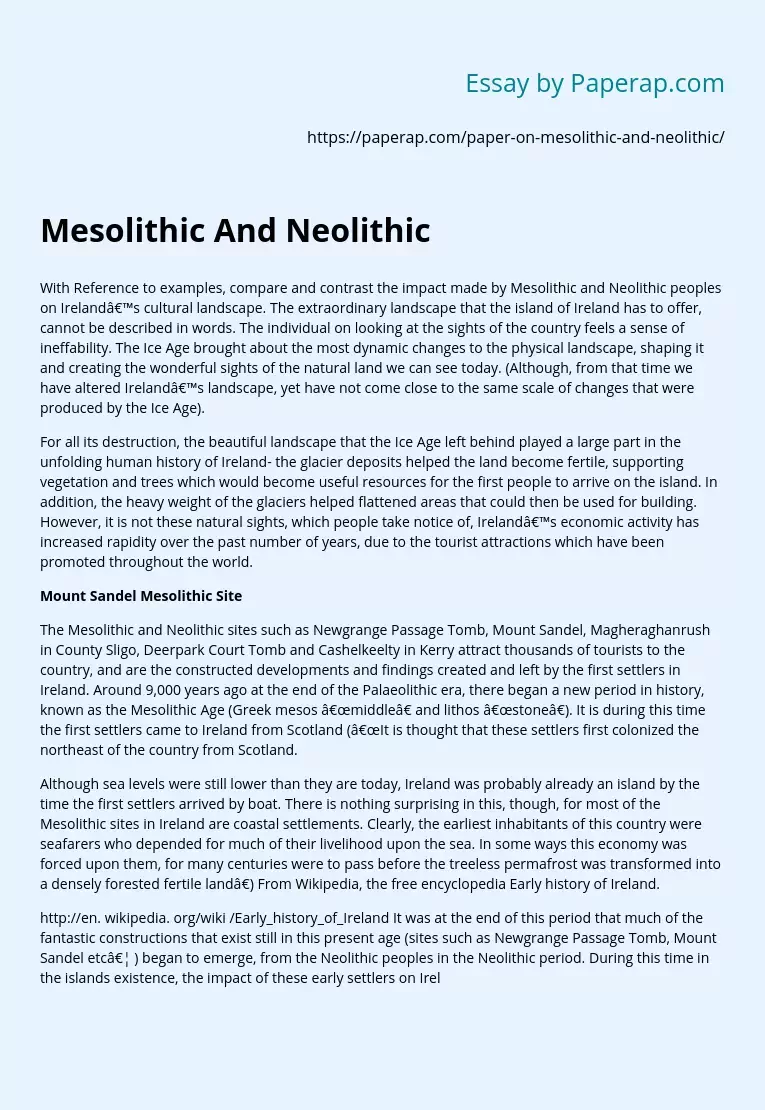Mesolithic And Neolithic
With Reference to examples, compare and contrast the impact made by Mesolithic and Neolithic peoples on Ireland’s cultural landscape. The extraordinary landscape that the island of Ireland has to offer, cannot be described in words. The individual on looking at the sights of the country feels a sense of ineffability. The Ice Age brought about the most dynamic changes to the physical landscape, shaping it and creating the wonderful sights of the natural land we can see today. (Although, from that time we have altered Ireland’s landscape, yet have not come close to the same scale of changes that were produced by the Ice Age).
For all its destruction, the beautiful landscape that the Ice Age left behind played a large part in the unfolding human history of Ireland- the glacier deposits helped the land become fertile, supporting vegetation and trees which would become useful resources for the first people to arrive on the island. In addition, the heavy weight of the glaciers helped flattened areas that could then be used for building.
However, it is not these natural sights, which people take notice of, Ireland’s economic activity has increased rapidity over the past number of years, due to the tourist attractions which have been promoted throughout the world.
Mount Sandel Mesolithic Site
The Mesolithic and Neolithic sites such as Newgrange Passage Tomb, Mount Sandel, Magheraghanrush in County Sligo, Deerpark Court Tomb and Cashelkeelty in Kerry attract thousands of tourists to the country, and are the constructed developments and findings created and left by the first settlers in Ireland.
Around 9,000 years ago at the end of the Palaeolithic era, there began a new period in history, known as the Mesolithic Age (Greek mesos “middle” and lithos “stone”). It is during this time the first settlers came to Ireland from Scotland (“It is thought that these settlers first colonized the northeast of the country from Scotland.
Although sea levels were still lower than they are today, Ireland was probably already an island by the time the first settlers arrived by boat. There is nothing surprising in this, though, for most of the Mesolithic sites in Ireland are coastal settlements. Clearly, the earliest inhabitants of this country were seafarers who depended for much of their livelihood upon the sea. In some ways this economy was forced upon them, for many centuries were to pass before the treeless permafrost was transformed into a densely forested fertile land”) From Wikipedia, the free encyclopedia Early history of Ireland.
http://en. wikipedia. org/wiki /Early_history_of_Ireland It was at the end of this period that much of the fantastic constructions that exist still in this present age (sites such as Newgrange Passage Tomb, Mount Sandel etc… ) began to emerge, from the Neolithic peoples in the Neolithic period. During this time in the islands existence, the impact of these early settlers on Ireland’s cultural landscape is thought to be much more significant than that of the Mesolithic people that lived before them, and it is this, which is to be discussed.
Mesolithic people lived in a hunter-gatherer society, were food was caught went needed for the family (usually hunted by the dominant male(s) of the group)- evidence of this comes from the Fourth International Congress of Primatology, Portland, Oregon, Male and Female Behaviour in Primate Societies. “The origin of male political power has been sought in the dominance behaviour of the nonhuman primates. Data from the living hunting and gathering peoples offer a corrective to this viewpoint.
Several theorists have developed models of early human groups that placed males at the centre and females drawn in from outside through exchange networks. These models contradict the known facts about hunting and gathering peoples, among whom we find a social grouping consisting of both males and females at the centre. The burden of the hunter-gatherer evidence (along with that from primate field studies) favours a model of early human society in which females wielded considerable political power as a result of their economic independence and their ability to exercise discretion in their choice of spouse.
We can establish that the sorts of animals the Mesolithic people consumed ranged over mammals, birds and fish including, wild boar, hare, wolf/dog, wild cat, thrush, eagle, wigeon, teal, mallard, salmon, trout, eel, seabass and a variety of other species, based on the findings at Mount Sandel. (J. P. Mallory & T. E. McNeill The Archaeology of Ulster; From Colonization to Plantation. 1991 P. 13).
Mesolithic And Neolithic. (2019, Dec 05). Retrieved from https://paperap.com/paper-on-mesolithic-and-neolithic/

